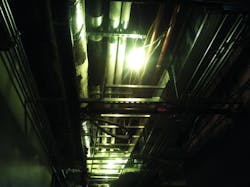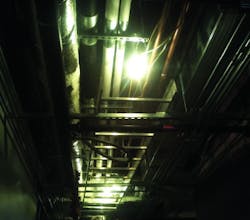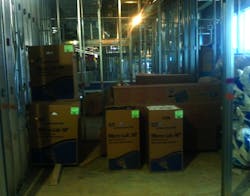Mastering the Electrical Work on a Mega Project
Imagine being given the task of managing a 500,000-hour job scheduled to take place over the course of four years. Most contractors and electricians would jump for joy if they landed a project of this magnitude. An undertaking of this scope, however, carries with it a myriad of challenges and complexities. To help you realize the many factors involved in such a large project, let’s analyze and review a job that IES Commercial secured in 2009.
- Resources — in this case, an unknown labor force
- Schedules
- Purchases
- Billing and cash flow
- Productivity
- Subcontractors
- General contractors
- Turnover
- Substance abuse
- Cost
- Lack of visibility at the task level
- Coordination with other trades
- Material price escalations
- Job-site logistics, including tool and material movement.
The required tools for management and mitigation of the technical, business, and integration risks have to be in place, trusted, and used if you want to safely navigate the difficulties of such work. In addition, plans for organizational structure, reporting structure, information flow, and other elements must be made. Although the tendency of many contractors is to treat this type of project as “a typical job,” this mind-set can lead to major problems and financial loss. Let’s review the processes and procedures that were used in this example to manage the risks and potential pitfalls.
Setting the Stage
Because this particular electrical project stretched over four years, it would be tempting to compare it to working on four individual $16.25 million projects per year — but it’s not that simple. The difference on this project was that supporting infrastructure had to be shared with all other projects running simultaneously.
To organize this massive job for daily, weekly, monthly, and annual management — in addition to the traditional project and cost tracking tools — we set out to add quality and integration tools to assure continuous monitoring and correction during the job progress. Mitigation of the risks was clearly divided between:
-
Technical Risks, which are electrically driven, such as: Code; inspection; design (including architectural, structural, and MEP systems); installation requirements; durability testing and QA/QC; contamination testing; electrician’s knowledge; as-builts; and submittals.
The above risks were managed with industry-standard procedures, processes, and tools.
-
Business Risks, which are monetary in nature, such as: invoicing; timesheets; material purchases; subcontractor’s payments; bonding; insurance; change orders; cash management; project organization structure and personnel; and profitability.The above risks were managed with IES’s existing business and financial management systems.
- Integration Risk, which is defined as bringing and aligning all of the pertinent elements needed to install the job, such as manpower, material, and money.
These risks possess the most critical and unknown factors during the progress of any large or small project. Any mishaps at the intersection of the three elements listed above are due to integration risk. These included but were not limited to:
- Coordination with other trades for design, layout, and physical work space
- Scheduling of work
- Reporting on work and quality of work
- Response to changes onsite
- Material problems, including logistics, and lay down areas
- Managing requirements of the daily work, the entire project, the company, and the environment, such as the general contractor, engineers, and architect/owner.
Managing the Work
Work Environment Management™ (WEM) was the tool used to manage the integration risk throughout this project. WEM relies primarily on usage of the newly developed ASTM standard for construction Job Productivity Measurement (ASTM E2691) as a feedback mechanism (see “Measuring Productivity in Construction” from the March 2011 issue of EC&M or visit http://ecmweb.com/training/measuring-productivity-construction).
Starting with the project schedule, the following elements of integration were set in place:
- General’s scheduled-plan (GSP)
- Work breakdown structure (WBS)
- Job productivity measurement (JPM) — Set up, usage, and reporting
- Electrical scheduled-plan (ESP)
- Three-week look-ahead scheduled plan
- Short interval scheduling™ (SIS) — set up, usage, and reporting
- Change management process and protocol.
For this article, we’ll explain IES’s approach to setting the elements in place for managing the integration risk of this project.
Initial Setup
Due to the size of this project, one of the first elements of WEM that was built was the WBS. This helped the project team see the project from the vantage point of the true work. IES had received little information on the GSP early on, but the job still had to be built. By putting together a WBS (Fig. 1), the job became visible and manageable in smaller sections. Once the WBS was created, the JPM baseline was established, and the project manager for IES could then track job productivity on a weekly basis.
In addition to the JPM setup, establishing SIS tracking was critical for the project, because it would be physically impossible to know what obstacles 100+ electricians encountered on a daily basis. The initial SIS reporting was set up to come in from a handful of lead electricians. However, as the project grew and became more complicated, the project manager decided to expand the usage to 15 field managers, each providing input on their crews’ ability to finish scheduled work (on a daily basis) — and what was getting in their way of doing so.
With the JPM and SIS tools in place, the job became more visible for tracking the special and common causes of variation on the project’s overall productivity. A weekly review of both measurements involved the project manager, senior project manager, and east region director of operations.
Review of the Job Information
In the weekly review of the project, the job’s overall productivity was reviewed and analyzed. Figure 2 shows the overall job productivity trend for the entire project. From here, the trend was broken down into cost codes to see what was driving the overall trend (Fig. 3).
Figure 3 shows how the cable tray was specifically problematic, revealing less-than-anticipated productivity from the labor productivity reference point. However, heavier weighted cost codes, such as feeder wire and feeder conduit, were performed with higher-than-expected productivity on the project. Because those codes comprised a higher weight of the project’s overall budgeted hours, they helped the overall job productivity stay above baseline, as noted in Fig. 2. Special causes of productivity variation were identified, explained, and noted for further investigation on a weekly timetable. For example:
- Cable tray (the blue line in Fig 3) became problematic because of the amount of coordination that was needed in the field to install it. Photo 1 shows an example of the tight space in the ceiling with multiple systems, including cable tray.
- Branch conduit (the yellow line in Fig. 3) trended slightly downward due to working in congested areas on the job site where other trades were present. Photo 2 shows other trades’ material being in the way of areas where branch conduit needed to be installed.
- The feeder conduit cost code (the purple line in Fig. 3) went very well on the installation, according to the crew and work observations.
Half of the trade interferences and waiting on trades was due to working with the masons. When the masons were laying their courses of brick, IES employees had to “stand by” and wait to insert their conduits. This resulted in a great deal of non-productive time, which affected the schedule. When the project manager and his field managers saw this, they approached the masons to see if they could get a little better “forecast” of what walls they planned to work and when so they could layout their own electrical daily work schedule in a more efficient manner. Once the mason interference declined, the job productivity increased (Fig. 5).
Absenteeism plagued the job daily, which is to be expected when trying to manage a crew this large. To combat this issue, the project manager used SIS input to determine if there were common absences or issues causing absence that needed to be addressed. Upon closer assessment, it was discovered that the relaxed procedures regarding personal days off (PDO) without adequate advanced notice to supervisors and foremen for coordination purposes could have caused superposition of how many people can take PDO at the same time, leading to unwanted consequence of absenteeism. MCA’s own research from SIS data across the country indicates that absenteeism is one of the top five reasons for not completing work according to the schedule.
Using the WEM Output to Manage Integration Risk
In addition to weekly reviews of productivity trends and obstacles, the project manager also used the original WBS and weekly input from the JPM observed % complete to develop an ESP that coincided with the GSP.
The senior project manager and the east region director of operations were able to use the trends showing up in the JPM outcome as a reference point. Additionally, they were able to pinpoint areas where they needed to escalate issues or help respond to problems the job had encountered. They were also able to correlate the WEM reporting with overall project financial health in a quarterly “audit” process.
Conclusion
Running a large project is not unlike running a company, with the difference of pace and the amount of risk involved in one large undertaking. The technical and business risks alone on a job of this magnitude must be planned and managed with your company’s best people and quality procedures. However, it’s crucial to understand that the integration risk is the largest unknown and has the fewest tools available in the industry to manage. Setting up a WEM system is a first step to making this risk visible. IES’s success on this project was its usage and response to the information provided by these types of processes and measurement/tracking tools.
Dr. Perry is president and CEO of MCA, Inc., Flint, Mich. Moore is vice president of operations. They can be reached at [email protected] and [email protected]. Werner is east region director of operations for IES Electrical; Warwick is a senior project manager. They can be reached at J[email protected] and [email protected].


